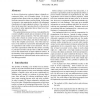Free Online Productivity Tools
i2Speak
i2Symbol
i2OCR
iTex2Img
iWeb2Print
iWeb2Shot
i2Type
iPdf2Split
iPdf2Merge
i2Bopomofo
i2Arabic
i2Style
i2Image
i2PDF
iLatex2Rtf
Sci2ools
CW
2002
IEEE
2002
IEEE
Direct Segmentation for Reverse Engineering
In Reverse Engineering a physical object is digitally reconstructed from a set of boundary points. In the segmentation phase these points are grouped into subsets to facilitate consecutive steps as surface fitting. In this paper we present a step segmentation method with subsequent classification of simple algebraic surfaces. Our method is direct in the sense that it operates directly on the point set in contrast to other approaches that are based on a triangulation of the data set. The segmentation process involves a fast algorithm for k-nearest neighbors search and an estimation of first and second order surface properties. The first order segmentation, that is based on normal vectors, provides an initial subdivision of the surface and detects sharp edges as well as flat or highly curved areas. One of the main features of our method is to proceed by alternating the steps of segmentation and normal vector estimation. The second order segmentation subdivides the surface according...
CW 2002 | Distributed And Parallel Computing | Order Segmentation | Simple Algebraic Surfaces | Step Segmentation Method |
Related Content
| Added | 14 Jul 2010 |
| Updated | 14 Jul 2010 |
| Type | Conference |
| Year | 2002 |
| Where | CW |
| Authors | Marek Vanco, Guido Brunnett |
Comments (0)

